It is a peculiar car: simple in appearance, but complex if you analyze it closely. It is a car of small size, but not minimal; three-cylinder naturally aspirated, but with 80 hp with which it is able to reach 180 km / h; very affordable price, but very equipped as standard; high for its width, but exceptional aerodynamics; well equipped, but simple and intuitive handling as a classic car. The personality of this car could even be described as bipolar. It's very simple, you could almost call it "retro" in the purely automotive aspect, but it has equipment more typical of the upper segments of a few years ago. It's like taking a city car from two decades ago and loading it up with the latest technologies, all while keeping the weight very much in check.
I have to admit that I have mixed feelings about the little Japanese car. It has a lot of flaws and things that leave a bit to be desired, seeing what other brands offer. However, it has that "something" that makes you overlook those details and feel happy behind the wheel. I'm on examples today, but it's like when you notice a certain girl who isn't the prettiest of the bunch. You don't know why, but you like that particular one. That's happened to me with this car, it's not the best I've ever had in objective terms, but I like it. It's certainly an option to consider.
What I say is reflected especially when driving it, giving the feeling of being one of those B-segment before the century, but with all (or almost) the comforts of our era. The engine is not at all refined, the gearbox does not have the best guided routes, some of its finishes squeak a little, but the overall package makes the Space Star a very complete car. What do we look for in a car of this type? That it is cheap to buy, that it is cheap to maintain, that it spends little, that it handles well in the city, that it can defend itself with ease outside of it and that it offers the most possible at the lowest price. With a file and test at hand, I can say that it more than fulfills these objectives.
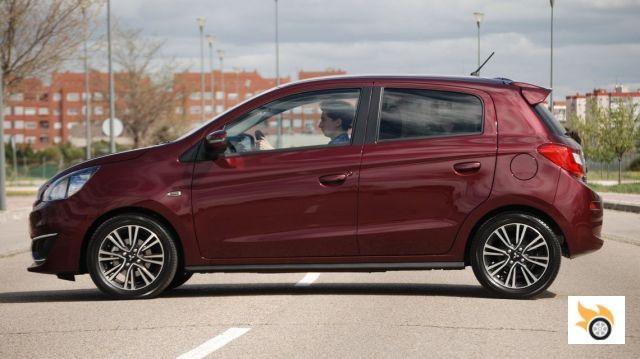
Design
It was exactly a year ago that the updated Space Star was unveiled, at the 2016 Geneva Motor Show to be exact.
The exterior dimensions were unchanged at 3,796mm long, 1,665mm wide and 1,505mm tall, with a wheelbase of 2,450mm, which translates to generous interior space. With 235 litres of boot space and a cleverly designed double floor, you'll have more than enough for everyday use. The restyling also worked on more efficient aerodynamics that, with a Cd of 0.27, the Space Star is one of the urban cars with better air penetration that exist, and I will comment on why it shows.
While it's true that the Motion trim is a little too discreet, the details of the Kaiteki version of this test unit make it a very good-looking city car.
The front end is undoubtedly where the changes are most noticeable. The new front grille and hood hump make the car a product with more packaging than before, it looks more macho. It is not that distills aggressiveness, but the pre-styling model had an air devoid of seriousness. The lower bumper gains in angles and chrome that bifurcate at the side ends to house the daytime running lights. The headlights, however, do not change, they are the same triangular shaped ones that extend towards the A-pillar.
For the more astute, some will have noticed that the design is teardrop-shaped, meaning that the front emanates from the rest of the car. Not only is it wider at the front, but it looks much wider than it actually is at the rear. It reminds me in part of the Peugeot 206 (because of the overall shape), which had particularly pronounced front wings denoting its front-wheel drive status. A design that makes you think at first glance that it is the front that "pulls" the car.
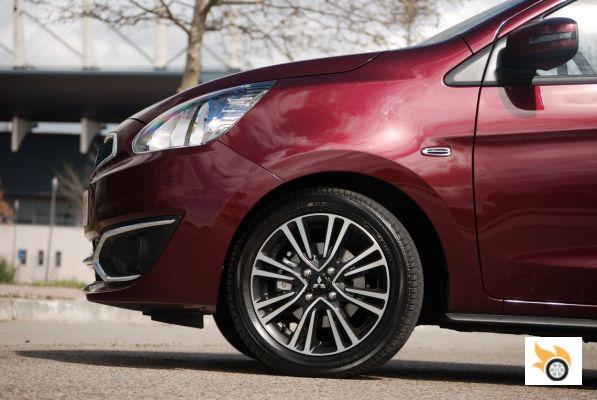
As usual in the updates of the cars, on the side there are hardly any changes. The rising beltline that starts at the front wheel arch and crosses the side to the rear lights, gives the car a dynamic image, as well as the small lower crease. The 15-inch wheels are new - and quite attractive, if I do say so myself. The LED side indicators are incorporated into the mirrors and, to avoid having to redo the front wings, the gap where the indicator used to be has been filled in with a graft that simulates an air intake, which is a bit of a cheesy thing to do.
And another similar detail that is not standard (fortunately), is that Mitsubishi offers us for the B pillar a decorative sheet with carbon fiber appearance for the modest price of 55.81 euros. To each his own, I know, but in my opinion, it's better to leave the car as it comes from the factory. The tinted rear windows are standard and very practical if we want to gain privacy or that the interior of our car is not so hot in the sun.
The rear has now a more angular and wider bumper, with integrated catadioptrics that help to reduce and stabilize the airflow while the spoiler and roof drop also reduce that friction. The rear spoiler is quite prominent, it houses the third brake light and I don't know if its intention is to gain sportiness already in passing, but if it wasn't the case, it succeeds. The rear lights have also been slightly redesigned, being of a small size but proportional to the rest of the car. At the same height, in the center, are the three diamonds next to the trunk door handle and the keyless lock button. The exhaust pipe is discreet, but if we want, for 43.41 euros, we can put a chrome finish.
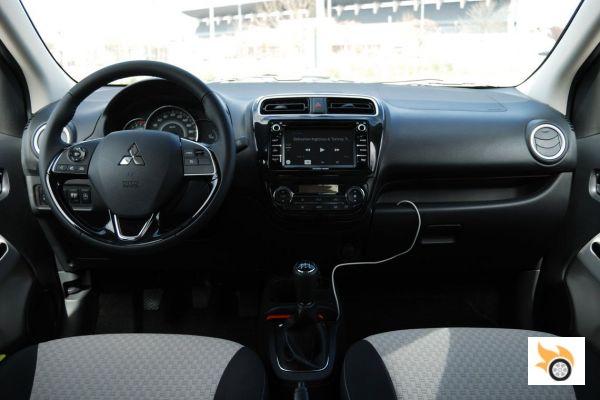
Cabin
Being a car with a size that places it halfway between segments A and B, we find a fairly spacious interior in all dimensions. Access to the seats, both front and rear, is quite comfortable, as the seats are located in a higher position than usual in these vehicles. At no time has the feeling of being boxed in.
One of the reasons that make the small Japanese car an option to consider within the group of small cars is its name: Space Star. "Space Star" sounds like a B-movie if you think about it in English. But basically what it is looking for is that, to be the best used car in space taking into account the limited exterior dimensions. It does not mean that we are going to find an incredible space inside, but it does slightly improve the average of its rivals.
The front seats are quite comfortable, with wide seats and little lateral support. It is homologated for five passengers, although the second row will be a bit tight, with its corresponding side ISOFIX. The side seats will be remarkable, with good legroom and headroom, but the central seat is insufficient. Being narrower and the pronounced transmission tunnel will only allow a fifth passenger to travel in case of need and on short journeys.
A nice detail is that, on the sides, behind the rear doors, there are specific holes to store the seat belt anchors when they are not in use. And speaking of the seat belts, the front ones can be adjusted in height, something not very common in cars of this segment, although necessary, because the height adjustment of the driver's seat is very scarce. It is also the only thing that can be adjusted, the steering wheel, as it lacks depth adjustment. This is something more normal within the segment.
The trunk, meanwhile, has a capacity of 235 liters (has not changed), but can be expanded to 912 liters by folding the seats (60:40) and adds, optionally (235.65 euros) a double floor compartment ideal for storing utensils and small objects in an orderly manner. Under it is located the puncture repair kit or a spare wheel "cookie" (150.07 euros).
On the practical side, in addition to a generous glovebox, which has a shelf above it where the co-driver can leave objects, there are several useful spaces under the center console, from the typical space to leave the phone and a couple of coasters, to a receptacle for the key (yes, it has push-button start), very practical to have it always located. There are bags in the front doors (in the back ones na nai de la china) and passengers in the rear seats have a bottle holder between the front seats, behind the handbrake.
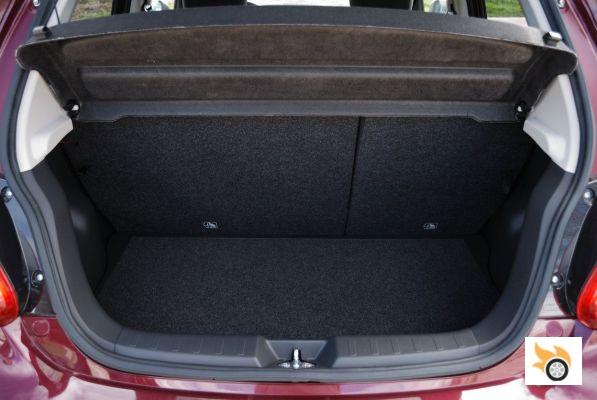
As for the interior finishes I don't know whether to laugh or cry. It doesn't boast a high level of quality in terms of materials, upholstery and trim, but it does show solidity throughout. Compared to the previous model, new upholstery and a multimedia system have been added, which makes the pre-refresh model look like it's a decade old.
Let's start with those "little details" of finishes that I mentioned at the beginning of the test. As I said, the interior itself is not poorly finished. In fact, despite being littered with hard plastics and having those "little details", this interior will certainly stand the test of time better than many of its rivals. I know it's a cliché, but Japanese interiors are known for being very well finished and lasting many years without creaking or cracking, and this one seems to be no exception.
The first thing I noticed when I got into the car is that, in the armrest/door pull holes, the screw that holds the moldings in place is brazenly visible; the transition between the fabric that joins the A-pillar and the roof is very noticeable, and the fabric of the A-pillar can sag; the directional controls for the air vents are very flimsy; the handsfree microphone is added a posteriori, is a bit sticky; the trunk tray does not always close well and only has a cord; the infotainment system seems to be taken from a store and coupled as if it were a 1 DIN radio; the feel of some plastics is... let's just say there are better ones. For example, the power window buttons are a bit spartan and only one of them is automatic. Is it so difficult to make at least the two front ones automatic?
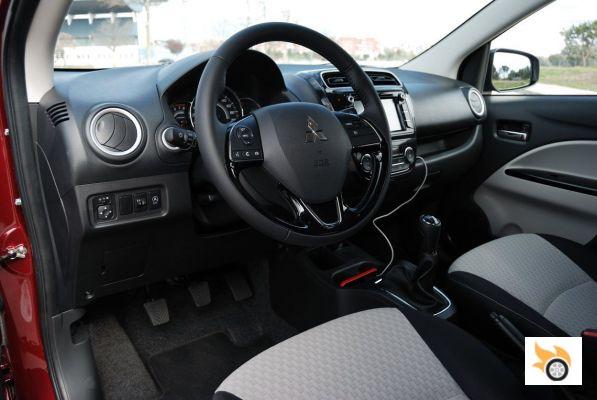
And those are details of the finish. It still has a few more that make it feel like a bit of a cheap (but not bad) car. Details such as the USB cable (and not port) and the auxiliary socket are in the glove box, or that the shift lever, despite being precise and short, often the gears do not enter the first time, but you have to "search" the gears. That the inside of the engine compartment and hood, as well as the inside of the gas cap and the wheel arches are not painted (or covered), are things that show that it is a car designed and made to be economical. I was amused, to give another (more) example, that the door handles on the front doors are metal and the rear ones are plastic.
Then there's the Piano Black trim, which gets dirty just by looking at it. It looks nice, but it's very dirty. In this finish we find it in the central area of the dashboard, door moldings and steering wheel spokes.
This version has multimedia control and cruise control from the steering wheel, which is a point in its favor, and embedded in the upper hollow of the steering wheel, at the bottom, the instrument panel, which mixes analog clocks with a small digital display with information on the fuel tank, average consumption, total mileage, partial, outside temperature, tire pressure detection and kilometers remaining until the next review. Another "retro" detail: the on-board computer is operated via a button on the dashboard. The instrument panel is simple and easy to read. I am negatively surprised that, instead of having a needle that shows the temperature of the oil, water, or an analog meter of the fuel tank, we have on the left side an ECO meter, to help us to drive more efficiently. Honestly, it seems silly to me when you can have the instantaneous consumption function on the on-board computer screen (which it doesn't have).
Although the interior features hard plastics, the gear knob and steering wheel are finished in leather.
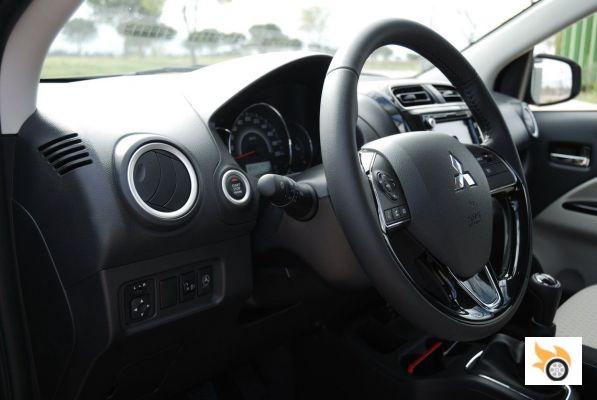
In the centre of the dashboard, the main protagonist is the 7-inch touchscreen multimedia system. The operation is quite simple and we will have the advantage of having TomTom navigation, although if we call us or we are to other moves the browser will not work, unlike other models that can. Very important, by the way, it has Apple CarPlay and Android Auto. Likewise, the system also supports Bluetooth, USB and auxiliary connection, whose sockets are located in the glovebox as I mentioned above. It's not the best screen in terms of fluidity and sensitivity, but it delivers. Below it, we find a single-zone climate control and an orange monochrome screen.
If we go for the most basic finish, the Motion, what we get is an economical Space Star, but not badly equipped. But for 1,000 euros more we get a Space Star that leaves little to be desired, the Kaiteki. This trim adds 15" alloy wheels to the Motion, exterior mirrors with exterior LED indicators, infotainment system, automatic climate control with anti-pollen filter, keyless door opening system and push-button engine start, as well as Start&Stop function.
That means that even in the most basic finish we find automatic stop and start system, leather steering wheel and knob, multifunction steering wheel, front and curtain airbags, hill start system, brake assist system, rain and light sensor and many more things. Not bad for 10,550 euros, really. However, for the Wine Red colour (the one in the photos) you'll have to pay 300 euros more.
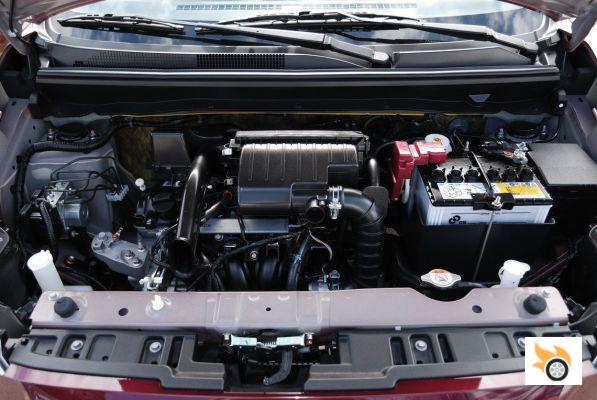
Technique
Here in Spain you can only get the Space Star with a single engine: a 1.2-liter naturally aspirated three-cylinder with which it manages to homologate one of the best fuel consumption in the segment (also helped by the low weight and aerodynamics worked); the previous 1.0 MPI is discontinued. It is an engine whose launch date dates back to 2003 and was first used in the Colt, as well as being fitted in the first generation Smart Forfour. That's why - despite the inevitable improvements - this engine isn't as refined as modern three-cylinders, although vibrations aren't as noticeable as you'd expect.
Its basic configuration of simple indirect injection is surprising, but the high compression ratio of 11:1, a value more typical of direct injection engines, is striking. Anyway, there's more work than you might think. This 1.2 also features Mitsubishi's MIVEC system, an elaborate dual variable valve timing that modifies the intake and exhaust timing, altering the crossover of its four valves per cylinder. In other words, more than proven technology, and effective.
The engine bay is used to the maximum, leaving little room for aesthetic refinements. The three-cylinder engine takes up almost no space at all.
When it came out in its day it must have been a surprising engine, because today, 14 years after its launch, it is still a light block (cylinder head and aluminium block), reliable, efficient and with a more than acceptable performance. This small engine delivers 80 hp of power at 6,000 RPM, with a maximum torque of 106 Nm at 4,000 RPM to the front wheels through a five-speed manual transmission. It is more than enough to move the whole, as it announces a top speed of 180 km / h and acceleration from 0 to 100 km / h in 11.7 seconds. This is associated with an approved fuel consumption of 4.3 liters in combined cycle and a low level of emissions of just 100 grams of CO2 per kilometer, which allows it to comply with current emissions regulations (Euro 6) and be exempt from payment of registration tax.
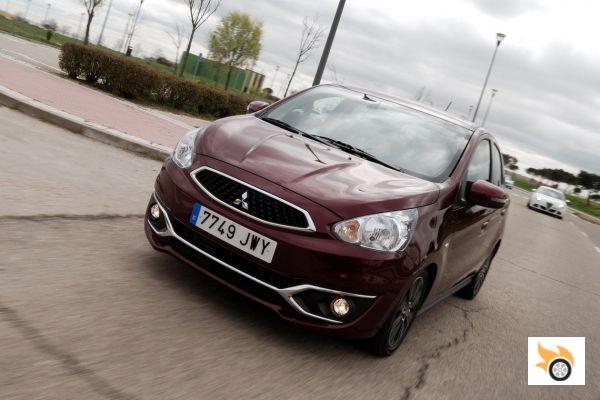
The "Clear Tec" sticker on the boot indicates that the car is equipped with technologies that improve efficiency by reducing fuel consumption and emissions. What kind of technologies? Well, a Start&Stop system called AS&G by Mitsubishi (which works when it feels like it), the use of low-viscosity oil, a gear change indicator, a high-efficiency alternator that recovers energy from braking, an aerodynamic design and Yokohama BlueEarth 175/55 low rolling resistance tyres.
Is it noticeable in practice? Obviously, the 4.3 litres per 100 kilometres claimed in the technical specifications is almost impossible, but not even close. In fact, the barely 50 kilometers that separate the Mitsubishi dealership where I picked up the car to my house (passing through Madrid center and, later, in my town), the average consumption showed a figure of 4.6 liters. On a day to day basis, around 5 litres is feasible. Going above 6 litres is very difficult, unless you live in an area with steep slopes, do a lot of motorway driving "lightly" and/or your right foot is very heavy. The only bad thing? The fuel tank is 35 litres, so you'll have to stop every half a thousand kilometres to drink, but you won't get many euros in.
There's nothing special about the transmission either, as it's a five-speed manual, which is reasonable for a car like this. As I've said before, it's pleasant to drive, with short travel, but not as precise as in some rivals. Sometimes it's not enough to just push the lever to the gear we want, because it won't go in, we have to "search" for the gear. Those who have cars more than fifteen years old will know what I mean.
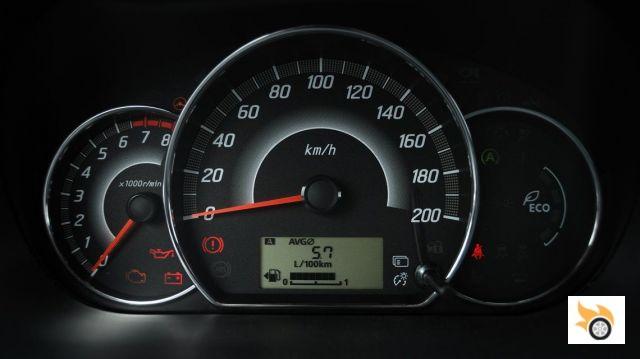
As for the gear ratios, they are long, especially for an engine whose power is at the highest revs on the rev counter. The top speed, theoretically, is reached at 6,250 rpm in fourth gear, or at 5,170 rpm in fifth gear. As for third gear, it reaches 135 km/h before the injection cut-off (a very long development), but in second gear you can reach 100 km/h. When you go in fifth gear at full throttle, the car is a real lighter, although we will have to reduce several gears if we want a good response.
The steering, despite being electric, has 3.5 turns of the steering wheel, very slow for such a small car. You have to be ready to steer and change the hands position at the slightest hesitation when facing a curve a little closed. The good thing is that the turning diameter is 9.2 meters, one of the best in the segment. On the other hand, the brakes comply perfectly despite having drums at the rear.
In the suspension scheme we are not going to surprise us with news. McPherson strut front axle and torsion bar on the rear axle. Something that is appreciated is that, either by its own constructive characteristics, or because the silent-blocks connecting to the monocoque are very soft, the rear axle has transverse parasitic movements when there are deformations in the pavement. Perhaps this is intended to punish the bodywork as little as possible on bad roads. Let's keep in mind that this car is destined to a multitude of markets, many of them are humble; it is also known as Mirage beyond our borders.
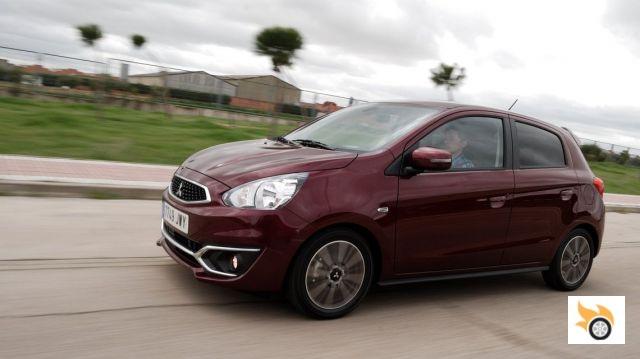
Driving
We get into the car and press the start button. The first thing we notice is the sound and vibrations it transmits, but it's nothing compared to what comes in the first meters: a really hoarse sound and more perceptible vibrations. This is an instant, as soon as you've finished releasing the clutch pedal to make the car move, it's not so noticeable. And it feels like a much fatter engine than a small three-cylinder, I swear. When stretching it (up to 6,500 RPM) it sounds as if we were driving a six-cylinder (saving the distances), it's cool.
Much ado about nothing, we could say. However, for having 80 hp, the power delivery is quite progressive, with enough energy at low revs, although its preferred area is the high area of the rev counter. As it has a very long development, go to third and fourth on the highway will be quite common. Driving on the highway at 120 km / h, sometimes, we will have to put fourth to face a hill without losing response. But it doesn't matter, playing with the gearbox is fun, it's a pity that sometimes it lacks some precision.
For me, rather than a defect, is a characteristic feature of the car, because it is a playful change, with a relatively short and mechanical travel. In fact, if we stretch the gears and change to an optimal rpm can get us some smile on twisty roads. Of course, keep in mind that its power steering is designed for the city, so it is not very precise, spending some time between turning the steering wheel and the car supports decidedly.
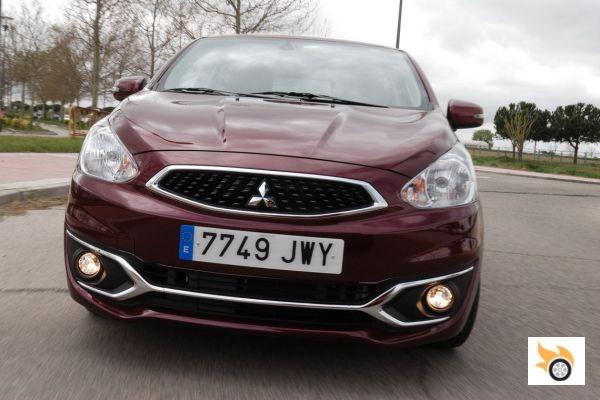
I did say it's noisy, didn't I? Well, it's only noisy above 3,500 revs and for the first few metres on start-up. After that, you hardly notice the noise. The only noise that is noticeable is the rolling noise, nor is the aerodynamic noise hardly noticeable (this is where the good work done by the designers and engineers of the brand is noticeable). It cuts through the air well, although as it weighs only 920 kg (845 kg with a full tank of petrol and without driver) and is relatively tall, if a strong side wind blows, it will be noticeable from inside the car.
If we are totally honest, those body movements are not only due to that, the suspension is too soft. Both springs and dampers have clearly soft settings, all of which contributes to the Space Star not being exactly the ideal vehicle for racing, although it has a healthy, progressive behavior that warns with a lot of margin. The result is that, although the car is not very understeering (the engine is very light and the front end is not overloaded), the roll on both axles is noticeable. And, with 175 section tyres of low resistance, this is more noticeable. As soon as we attack a little, the car moves forward a little bit on one side, but don't worry, it's difficult to do anything crazy with the car. Also, the traction control can't be switched off. At least I haven't found the button or any information on the internet explaining how to do it. It has a noble response, but don't look for the tickle because it's a very pigeonholed urban car in its segment.
The AS&G system isn't as accurate as it could be, but when it works, it responds quickly and is smooth in the on-off transition.
In the end, one of the main reasons to buy this car is going to be fuel economy. Thanks to its low weight, good aerodynamics and a not very greedy engine, it won't be difficult to get around five litres on average, six if we don't take it out of the city, but no more.
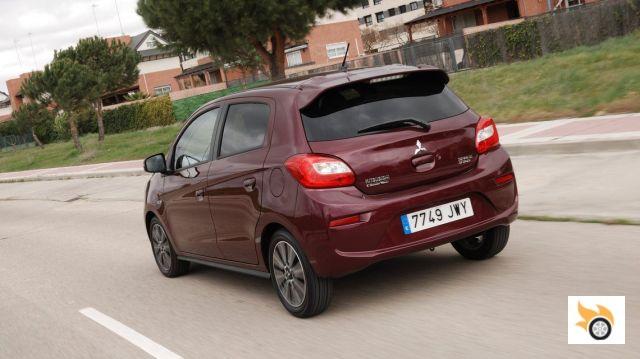
Conclusions
With a renewal of the model last year, the Space Star is postulated as one of the most interesting options in the A-segment. It has gone from having a good-natured and dull air to a more youthful and dynamic look. It doesn't have a lot of customization, something that's all the rage right now, but it's very much on par with the Ford Ka+ in terms of price/space/equipment, so choosing between the two will be more a matter of taste and price than anything else.
It has the feel of a more "classic" car, and that's not a drawback. For those who find new cars a bit too finicky, the Space Star will take you back a few years without having to compromise on comfort and safety. It might even bring a smile to your face without having to push it to the limit. True, it doesn't have the dynamic appeal of other alternatives due to its suspension setup and long shifter travel. However, during my brief but intense experience, I did find it a nice car to drive.
Its roominess is above average, offering a fairly spacious interior and approved for five people. The equipment offered for just over 10,000 euros is unbeatable, and for 11,550 euros you get a very complete car. It is a car for all those looking for a small car at a good price and that does not lack anything. In the case of the basic, you can not reproach the lack of power of the now retired 1.0 MPI.

























